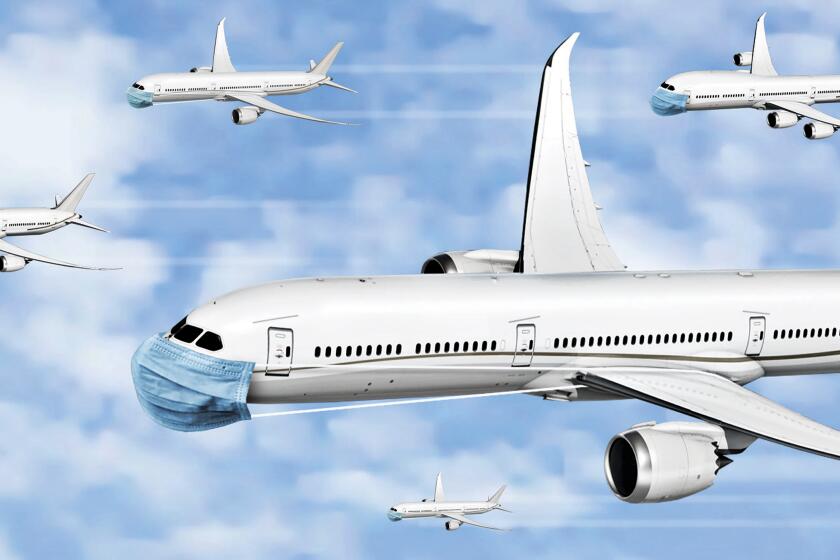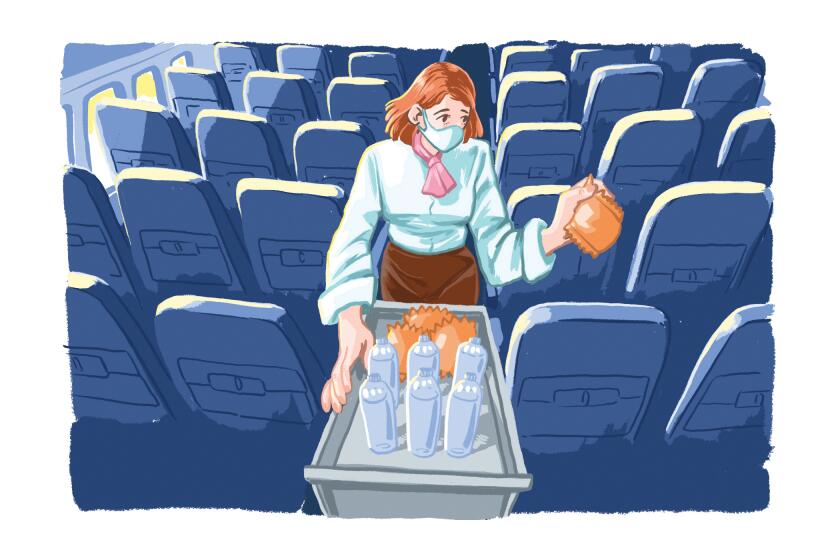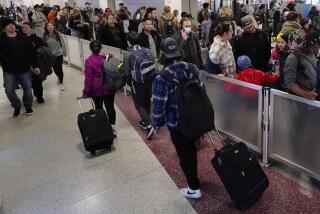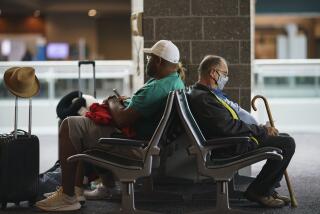Flying during coronavirus is nothing like it used to be. Who’s doing it?
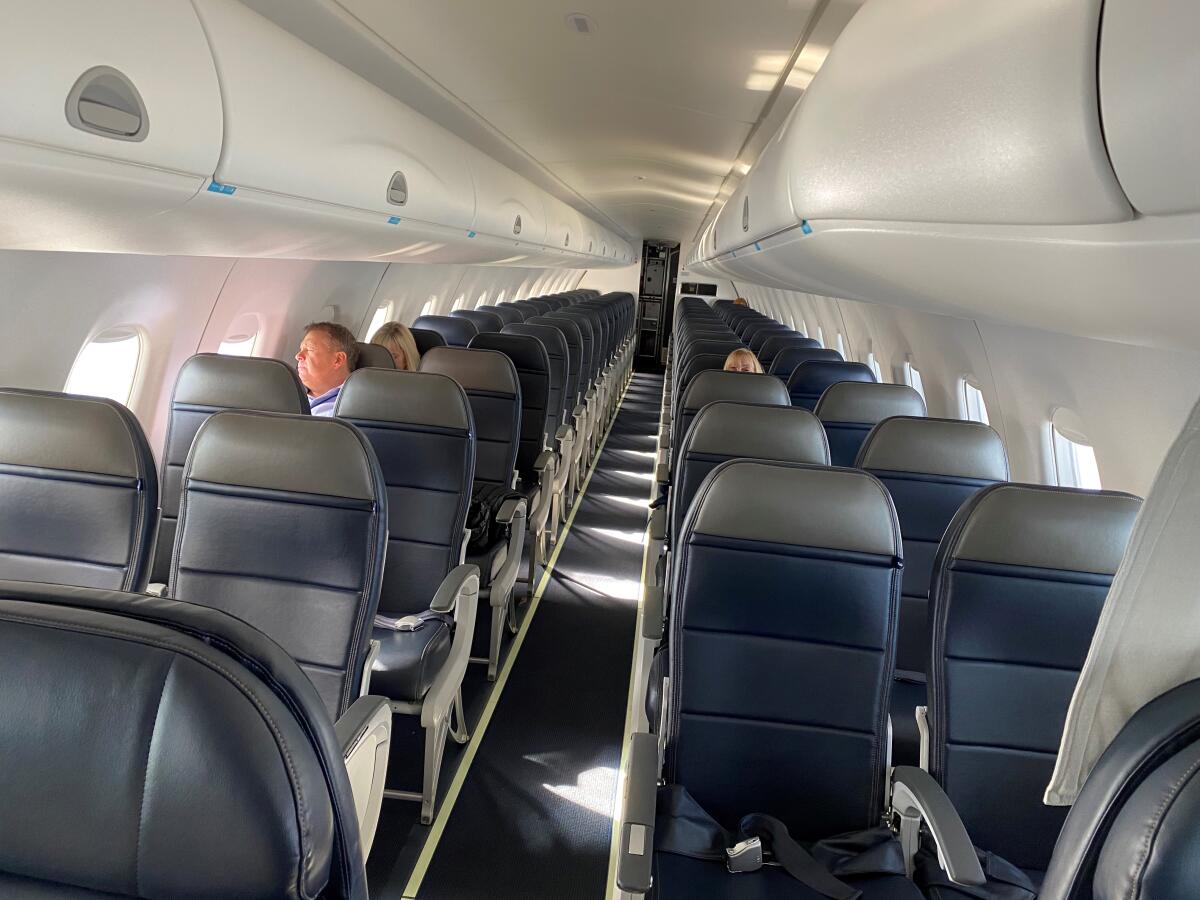
- Share via
When Bill Nord’s boss asked for a volunteer last week to fly to Denver for an assignment, Nord accepted, telling himself that a round trip from Santa Ana in the middle of a pandemic “sounds like an adventure.”
Nord, a 56-year-old inspector who certifies that foods and products are organic, planned to wear a mask during the flight. Plus, he is in good shape from bike riding along the beach.
But his confidence was shaken when he heard another passenger on the nearly empty plane cough repeatedly. “Oh, no,” he recalls thinking. “I’m taking a real chance.”
The coronavirus outbreak that has infected more than 600,000 people in the U.S. has pushed the demand for air travel down by 95% in the past week, compared to the same time last year, according to a trade group for the country’s airlines.
That remaining 5% includes people like Nord, who feel it is relatively safe to fly or decide they must risk their health to travel for a work assignment or a family obligation.
Airline passengers who are braving confinement in a plane cabin include an elderly woman moving to an assisted living facility in Tucson to be closer to her family; a parent heading to help his daughter move back home after college dorms closed; a father-to-be picking up his new baby from a surrogate mother in Arkansas and vacationers cutting short trips abroad to ride out the crisis at home.
Flight attendants want nonessential flights to stop amid coronavirus outbreak
Other airline passengers include pilots and flight attendants commuting home after completing work shifts and medical staff traveling to hard-hit regions of the country to help treat victims of the outbreak.
Those who have flown in the past few weeks describe the experience as a mixture of anxiety over the increased risk of being exposed to the virus and amazement over the sight of nearly abandoned airport terminals and almost empty airplane cabins.
“The airport was about as empty as the planes were,” said Dennis Raveneau, a retired teacher and actor who recently returned to Dallas from a vacation in Paris. “There were no crowds at all.”
Most Americans are under stay-at-home orders to slow the spread of the virus, but commercial flights continue to crisscross the skies for several reasons.
A provision of the federal government’s $2-trillion stimulus bill requires airlines to continue flying to the cities they previously served if they want to qualify for federal grants. Airlines are also flying to transport cargo across the country.
Dramatically cutting air service would also mean storing planes in remote desert airports, an expense airlines want to avoid.
“Our elected officials want us to provide safe air travel through this crisis, and they want us to be up and flying when demand for travel picks up again,” American Airlines Chief Executive Doug Parker said in a recent video message to his employees.
A union representing about 50,000 flight attendants at 20 airlines wrote to the U.S. Department of Transportation on March 31, urging the agency to halt all leisure air travel, limiting all passenger flights to essential services, such as flying medical supplies and first responders to hard-hit areas of the country.
Airline representatives say it is difficult to tell how many passengers are now flying out of necessity and how many are still traveling for leisure.
Passengers on recent flights say they have been allowed to spread out in the cabin — an airborne version of social distancing. Most airlines have either stopped serving food or offer only a box lunch to cut back on the contact between passengers and flight attendants.
More than 100 flight attendants on one airline have tested positive for the coronavirus. Have airlines done enough?
“They pretty much sit there and watch movies on their computer and sleep because they have an entire row to themselves,” said Rock Salomon, an American Airlines flight attendant based in Boston. “My last trip to Phoenix had less than 20 passengers on each leg.”
Those who have been flying during the pandemic are finding air fares down 29% or more, with nonstop, round trip tickets from Los Angeles to Miami now selling for as little as $153.
Airlines don’t require passengers to wear masks and gloves on planes but encourage travelers to abide by the recommendations of the Centers for Disease Control and Prevention. Last month, the nation’s largest airlines gave flight attendants the go-ahead to wear gloves and masks while serving passengers.
Although dozens of flight attendants, ticket agents, TSA agents and CDC health screeners have tested positive for the virus, it is unclear how many travelers could have contracted the virus while flying on a commercial plane.
Still, some passengers say they felt anxious flying in close quarters with strangers who could be infected with the coronavirus.
Andrea Perdue returned not long ago from attending a wedding in Chile that was planned last year. The Highland Park translator said she felt nervous about her flight when officials at the airport in Chile took the temperatures of all the passengers and asked them to sign a document saying they had no symptoms.
“On the way back to L.A., the situation was much more tense,” she said. “The flight still had a lot of passengers but most were wearing masks.”
Social distancing — a term we’ve all become familiar with — has been nearly impossible to accomplish on an airplane. Until now.
Danny Roman, who runs a tour company in Los Angeles, is worried about a flight he is taking in two weeks to Arkansas to adopt a baby that a surrogate mother is expected to deliver.
“So, I have to get in two planes to get there,” he said. “Having my baby and then flying back with my newborn is absolutely terrifying.”
Other travelers who flew recently said they felt relatively safe because they took precautions before boarding.
Kevin Jones, a film professor at the University of North Carolina School of the Arts, flew back to his home in Los Angeles last week after face-to-face classes were replaced with online courses.
He said about 40 people were on the last leg of his Delta Air Lines flight to Los Angeles but no one sat within a few rows of him. Jones wore gloves and a surgical mask the entire way. After taking a nap on the flight, he said he woke to find a box lunch and a small bottle of hand sanitizer in the seat next to him.
“Loading and unloading a plane when no one is on is pretty easy,” he said. “When I went to the baggage claim there was no wait. My bag was right there when I got there.”
Raveneau, the retired teacher, said he and his wife cut their vacation in Paris short to ride out the pandemic at home. He said he wasn’t nervous about the flight back home because he and his wife both had N95 respirator masks.
As the coronavirus outbreak squelchs travel demand, flights are being cancelled, airports are empty and grounded planes are turning remote airports into big parking lots.
But when they landed in Dallas, Raveneau said he became unnerved when Texas state troopers who wore no gloves or masks rounded up the passengers on his flight in a small room to fill out customs and medical forms.
Raveneau, who vacations in Paris annually, has no plans to fly soon. “We are going to stay put for a while,” he said.
Nord, the organic food and products inspector, said he would still consider flying for work in the future, despite the scare with the coughing passenger on his last flight to Denver to inspect a CBD production facility.
“I wouldn’t jump at it,” he said of another out-of-town work assignment. “I’d take a deep breath first and maybe wait until June or July.”
More to Read
Inside the business of entertainment
The Wide Shot brings you news, analysis and insights on everything from streaming wars to production — and what it all means for the future.
You may occasionally receive promotional content from the Los Angeles Times.


